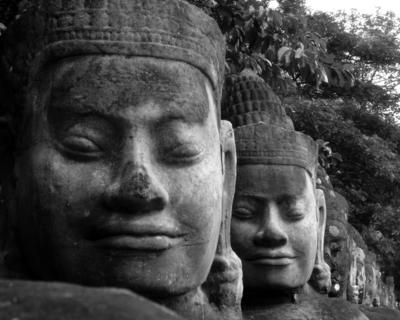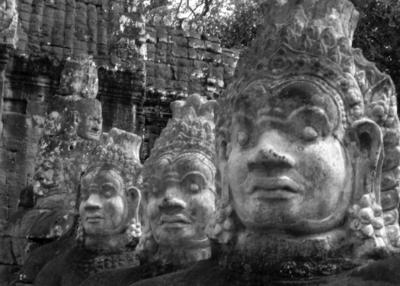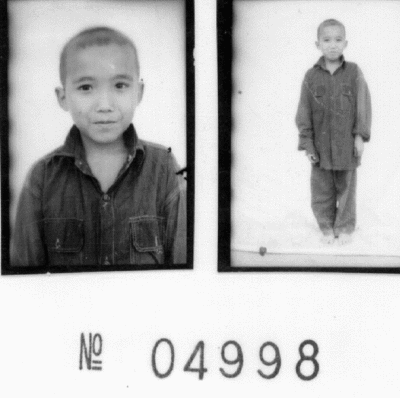
A nameless victim of the Cambodian genocide. Few Americans know that close to two million people died, that none of the perpetrators have been brought to justice and that the United States helped bring about the crisis that lead to the Khmer Rouge takeover.
On April 17, 1975, "The Day of Anger", as it is remembered, thousands of Phnom Penh residents celebrated in the streets as Khmer Rouge troops victoriously entered the capitol. This joyous celebration of the end of the five-year civil war was an expression of hope that Cambodia would finally be at peace.
Hope quickly turned to fear as the Khmer Rouge troops, embittered and toughened by years of brutal civil war and American bombing, marched the boulevards of Phnom Penh ordering people to abandon their homes and evaquate the city. When the residents questioned their orders, the Khmer Rouge claimed they wanted to save as many people as possible from the imminent attack of the Americans, who would soon be bombing the city. Residents would only be gone a few days, they were told, so there was no need to take personal belongings or much food. 2 million people were forced from the city to the countryside, on foot. The wounded were forced out of hospitals to make the trek; some of them were wheeled out on hospital beds. Many died along the way.
There were no American plans to attack the city, as the Khmer Rouge well knew. Cities, they believed, were living, breathing capitalist tools, and Phnom Phen was "the great prostitute of the Mekong." In an ideal communist society, all people would have to live and work in the countryside as peasants, the Khmer Rouge communist ideal. 'Old people', as they called them, were simple, uneducated, hard-working, and almost incapable of exploiting others. Though their way of life had not changed for centuries, they always managed to survive. City dwellers, or 'new people', were the root of all capitalist evil whether they were teachers, tailors, civil servants or monks, and instantly became the new enemies of Angka, "The Organization".
As was often said by the Khmer Rouge, 2000 years of Cambodian history had now come to an end; April 17 was the beginning of Year Zero for the new Cambodia: Democratic Kampuchea. Religion, money and private ownership were all banned; communications with the outside world elimated; family relationships dismantled. The Khmer Rouge regime arrested, tortured and eventually executed anyone suspected of connections with the former or foreign governments, professionals, intellectuals and any Khmer person who broke their rules. Ethnic Vietnamese, Cambodian Christians, Muslims and the Buddhist monkhood were also targets of persecution. If a person knew a foreign language, had worked for the French or Americans, or dared to express feelings of love to their husband or wife, they were killed. Almost 2 million Cambodians would die, 30% of the Cambodian population during that time. Cambodians began to refer to their country as the killing fields, a land of skulls and bones with rivers of blood.
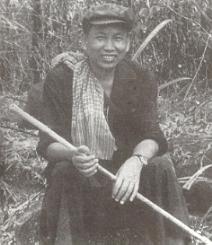
Little was known of the leader of the Khmer Rouge, a Paris-educated communist named Saloth Sar, who went by the nom de guerre “Pol Pot.” Often compared with the regimes of
Adolf Hitler,
Joseph Stalin, and
Mao Zedong, the Khmer Rouge was probably the most lethal regime of the 20th century, in terms of the number of people killed relative to the population. Nevertheless, only three of the Khmer Rouge leaders have been imprisoned since their rule ended, one on unrelated charges.
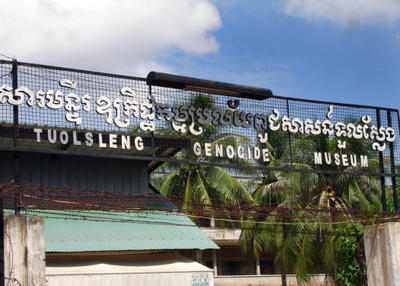
As hundreds of thousands of Cambodians slowly starved in the rice fields, a select number of political prisoners and their families met a terrible fate inside Khmer Rouge interrogation centers. The most infamous of these centers, codenamed S-21, was located in the abandoned suburban Phnom Penh high school of Tuol Sleng, "hill of the poison tree." To workers assigned by the Khmer Rouge to the Tuol Sleng neighborhood, S-21 was known simply askonlaenh choul min dael chenh - "the place where people go in but never come out." Tuol Sleng's reputation was brutally accurate: the sole purpose of S-21 was to extract confessions from political prisoners before they were taken away for execution near the farming village of Choeung Ek. Of the 20,000 people known to have entered Tuol Sleng, only six are known to have survived.
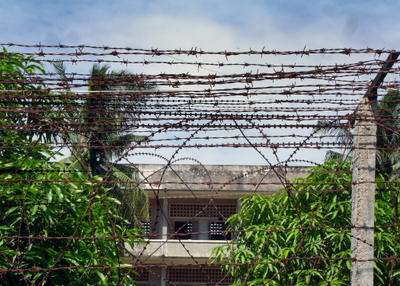
Thousands of confession files, including
5,000 photographs, survive to this day, giving us a grim look at the activities that occured inside Tuol Sleng. The
Yale Cambodian Genocide Centerhas spent many years examining these records, but thousands of the people sent to S-21 have yet to be identified. We may never know who they were or why they were sent there;
only their portraits remain to serve as affirmations of their lives - and deaths - at the hands of the Khmer Rouge. When I asked why they had bothered to photograph all their victims, leaving proof of their crimes, my guide told me they wanted to prove to Angka that they were doing their job.
The shadows of barbed wire lining the hallways of Toul Sleng, added after a woman committed suicide by jumping from the second floor to escape her torturous fate. Another victim managed to take hold of a gun left in a torture chamber, shoot his gaurd, and then take his own life.
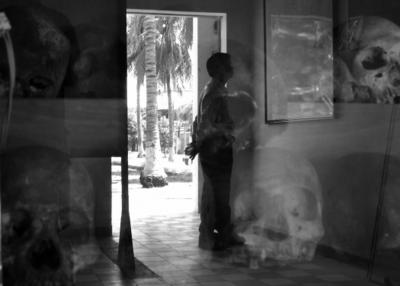
Our guide through Tuol Sleng and Cheong Ek, Mr. Ran, refelcted in a glass case containing the skulls of victims unearthed on school grounds. Hundreds of Cambodians now make a living by guiding visitors through the killing fields, many sharing their harrowing personal stories of how they survived the Khmer Rouge.
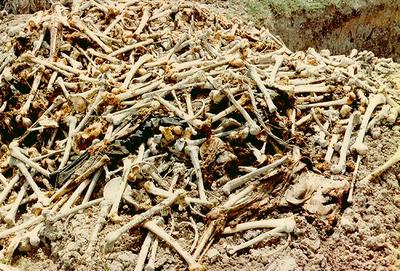
The Killing Fields at Choeung Ek. This mass grave, discovered in 1980, was one of the first proofs to the outside world of what had occurred during Pol Pot's regime.
Mr. Ran explained that bullets were too precious to use for executions. Pick axes, knives and bamboo sticks were far more common. Even the jagged egde of this common Cambodian plant became a tool for torture and murder.
A memorial stupa stands in the center of the killing fields, housing 8,000 skulls from the surrounding mass graves.
The Cambodian flag, outlawed by the Khmer Rouge, reflected in the glass shrine of the killing fields.
The sight of the skulls stuns visitors into silence. Cambodians will tell you that their genocide is worse than any other because it was carried out on Cambodians, by Cambodians.
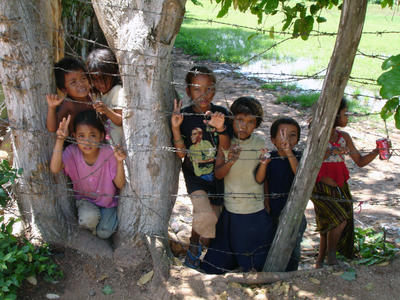
Children from the surrounding farms greet visitors to the killing fields, begging for money.
Nine miles from Phnom Penh, the "killing fields" of Choeung Ek are a few of thousands of other such sites around the country where the Khmer Rouge committed genocide during the late 1970s. Water buffalo graze in the surrounding farmland as human bones are unearthed after heavy rains. As i walked through the feilds, I struggled not to step on bones pooking through the dirt paths, discovered by the monsoon rain. Along the path, small barrels were filling with the remains of the thousands of victims massacred here.
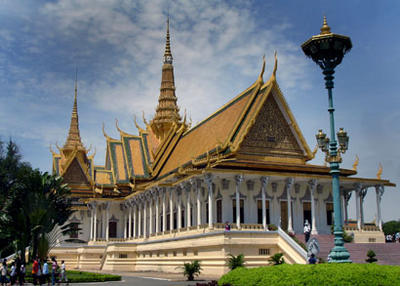


 Little was known of the leader of the Khmer Rouge, a Paris-educated communist named Saloth Sar, who went by the nom de guerre “Pol Pot.” Often compared with the regimes of
Little was known of the leader of the Khmer Rouge, a Paris-educated communist named Saloth Sar, who went by the nom de guerre “Pol Pot.” Often compared with the regimes of 


 The Killing Fields at Choeung Ek. This mass grave, discovered in 1980, was one of the first proofs to the outside world of what had occurred during Pol Pot's regime.
The Killing Fields at Choeung Ek. This mass grave, discovered in 1980, was one of the first proofs to the outside world of what had occurred during Pol Pot's regime.

